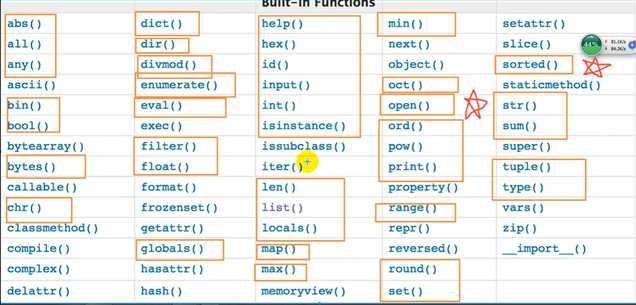标签:ipython core index oat 包括 浮点 int() contains 字符

1. abs(): 绝对值

In [1]: abs(-10)
Out[1]: 10
2. all(): 当参数中任何一个值为False时,all() 都为False
all(iterable) --> bool
bool值为False:0、None、()、‘‘、{}、[]

In [2]: all([‘1‘,‘abc‘, None]) Out[2]: False
3. any(): 和all()相反,当参数中任何一个值为True时,all() 都为True

In [3]: any([‘1‘,‘abc‘, None]) Out[3]: True
4. bin(): 将整数x转换为二进制字符串

In [4]: bin(100) Out[4]: ‘0b1100100‘
5. bool(): 判断值为True or False

In [5]: bool(123)
Out[5]: True
6. type(): 讲值转换为字符类型

In [6]: i = bytes(‘123‘, encoding=‘utf-8‘) In [7]: i Out[7]: b‘123‘ In [8]: type(i) Out[8]: bytes
7. chr(): 返回整数i对应的ASCII字符。

In [9]: chr(97) Out[9]: ‘a‘
8. ord(): 与chr()相反,返回ASCII字符对应的整数i

In [12]: ord(‘a‘) Out[12]: 97
9. dict(): 定义字典类型

In [13]: dict()
Out[13]: {}
10. dir(): 返回当前范围内的变量、方法和定义的类型列表

In [14]: s = ‘abc‘ In [15]: dir(s) Out[15]: [‘__add__‘, ‘__class__‘, ‘__contains__‘, ‘__delattr__‘, ... ...
11. divmod(): divmod(a,b)方法返回的是a//b(除法取整)以及a对b的余数,返回结果类型为tuple,多用于分页

In [16]: divmod(9,2)
Out[16]: (4, 1)
12. enumerate(): 对于一个iterable, enumerate将其组成一个索引序列,利用它可以同时获得索引和值

In [17]: d = {1:‘aa‘, 2:‘bb‘, 3:‘cc‘}
In [18]: for index, item in enumerate(d):
...: print(index,item)
...:
0 1
1 2
2 3
13. eval(): 将字符串str当成有效的表达式来求值并返回计算结果。

In [19]: eval(‘1+2+3+4+5‘) Out[19]: 15
14. filter(): 包括两个参数,分别是function和iterable, 该函数根据function参数返回的结果是否为真来过滤list参数中的项,最后返回一个新列表

In [20]: f = filter(lambda x:x > 2, [1,2,3,4,5]) In [21]: print(list(f)) [3, 4, 5]
15. float(): 浮点数类型

In [22]: float(100)
Out[22]: 100.0
16. globals(): 在当前作用域下,查看全局变量

In [23]: s = ‘abc‘ In [24]: globals() ... ‘quit‘: <IPython.core.autocall.ExitAutocall at 0x7f58ca9f5710>, ‘s‘: ‘abc‘}
17. help(): 查看帮助

In [25]: help(‘abc‘)
18. hex(): 本函数是转换一个整数对象为十六进制的字符串

In [26]: hex(123) Out[26]: ‘0x7b‘
19. id(): 返回的是对象的“身份证号”,唯一且不变

In [27]: a = ‘abc‘ In [28]: id(a) Out[28]: 140019516325088
20. input(): 接收用户输入

In [32]: i = input(‘enter your number:‘) enter your number:10 In [33]: i Out[33]: ‘10‘
21. int():定义整数类型

In [34]: i = int() In [35]: type(i) Out[35]: int
22. isinstance(object, classinfo): 如果参数object是classinfo的实例,或者object是classinfo类的子类的一个实例, 返回True。如果object不是一个给定类型的的对象, 则返回结果总是False

In [36]: isinstance(‘abc‘, str) Out[36]: True In [37]: isinstance(123, str) Out[37]: False
23. len(): 获取iterable的索引长度

In [39]: len(‘123‘) Out[39]: 3
24. list(): 定义列表类型

In [42]: l = list() In [43]: l Out[43]: [] In [44]: type(l) Out[44]: list
25. locals(): 局部变量函数locals

def f(): x = 1 y = 2 return locals() f1 = f() print(f1)
26. map(function, iterable): 接收一个函数 f 和一个 list,并通过把函数 f 依次作用在 list 的每个元素上,得到一个新的 list 并返回。

def f(i): return i + i l = map(f,[1,2,3,4,5]) print(list(l)) # [2, 4, 6, 8, 10]
27. max(): 却列表中的最大值

In [46]: max(1,2,3,4,)
Out[46]: 4
28. min(): 取列表中的最小值

In [47]: min(1,2,3,4)
Out[47]: 1
29. oct(): 将一个整数转换成8进制字符串

In [48]: oct(12) Out[48]: ‘0o14‘
30. open(‘path to file’, ‘mode‘): 打开一个文件

f = open(‘D:\\test.txt‘, ‘r‘) r = f.read() print(r) f.close()
31. ord(): 以一个字符作为参数,返回对应的ASCII数值

In [2]: ord(‘a‘) Out[2]: 97
32. pow(x, y): 函数是计算x的y次方.

In [7]: pow(2,4)
Out[7]: 16
33. print(): 打印

In [8]: print(‘hello‘) hello
34. range(): 在python3中,使用range并不会直接返回一个列表,需要配合list()

In [10]: list(range(0, 10))
Out[10]: [0, 1, 2, 3, 4, 5, 6, 7, 8, 9]
35. round(): 返回浮点数x的五舍六入值。

In [17]: round(0.5) Out[17]: 0 In [18]: round(0.6) Out[18]: 1
36. set(): 定义set类型,set类型特点:无序, 不重复

In [20]: s = set({1,2,3,4})
In [21]: s
Out[21]: {1, 2, 3, 4}
37. sorted(): 用于同一种类型进行排序

In [24]: sorted([1,2,3,4,9,5,6]) Out[24]: [1, 2, 3, 4, 5, 6, 9] In [25]: sorted([‘a‘,‘c‘,‘b‘]) Out[25]: [‘a‘, ‘b‘, ‘c‘]
38. str(): 字符串类型

In [27]: s = str(‘abc‘) In [28]: type(s) Out[28]: str
39. sum(): 可迭代的整数列表求和

In [30]: sum([1,2,3]) Out[30]: 6 In [31]: sum((1,2,3)) Out[31]: 6
40. tuple(): 定义元组类型

In [37]: t = tuple(‘123‘) In [38]: t Out[38]: (‘1‘, ‘2‘, ‘3‘) In [39]: type(t) Out[39]: tuple
41. type() 查看值的类型

In [40]: l = [‘a‘,‘b‘,‘c‘] In [41]: type(l) Out[41]: list
标签:ipython core index oat 包括 浮点 int() contains 字符
原文地址:http://www.cnblogs.com/hukey/p/7001256.html